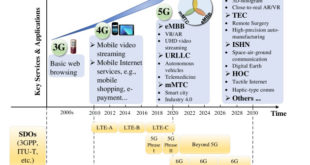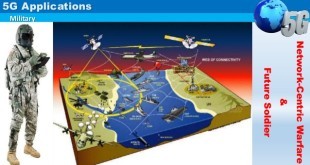Introduction Wearable technology has taken the world by storm, transforming the way we interact with our surroundings and enhancing our daily lives. From smartwatches to fitness trackers, wearable devices have become an integral part of our digital ecosystem. In this blog article, we will explore the burgeoning wearable technology market, …
Read More »Unveiling the Future: Exploring 6G’s Vision, Requirements, Challenges, and Technology Roadmap
Introduction: 6G, the next generation of mobile cellular technology, is set to revolutionize the way we connect, communicate, and interact with our devices and the world around us. With promises of ultra-high-speeds, low latency, and unprecedented capabilities, 6G holds the key to unlocking a new era of connectivity. In this …
Read More »5G Dominance: Unveiling the US Military’s Strategic Leap and the Rise of a 5G Arms Race
In a bold move that marks a significant shift in the landscape of modern warfare, the United States has officially launched its 5G military strategy, declaring the race for 5G dominance as a new arms race. This development is set to reshape the future of military operations, with profound implications …
Read More »Unleashing the Power of Modular Quantum Computers: Towards Large-Scale Programmable Quantum Computing and the Quantum Internet
Introduction Quantum computing has emerged as a groundbreaking field that promises to revolutionize the way we process information and solve complex problems. Among the exciting advancements in this realm, modular quantum computers have taken center stage. These modular systems offer the potential to scale up and unlock the possibilities of …
Read More »Optical Modules and Transceivers: Unleashing the Power of High-Speed Optical Communications”
Introduction: In today’s digital age, where data transmission and connectivity are paramount, optical modules and transceivers have emerged as critical components for high-speed and reliable optical communications. These advanced technologies play a vital role in various applications, ranging from data centers and telecommunications networks to emerging technologies like 5G and …
Read More »Predicting Military HF Radio Communications with Distributed Sensors: DARPA’s Canun Mission Planning Tool
Whether in the field of battle, search-and-rescue or humanitarian aid efforts, the ability to share real-time, networked information between ground, sea and airborne forces is rapidly becoming the defining factor in a mission’s success. However modern satellite and other communications systems in higher frequecies are under constant threat from adversaries …
Read More »Optical Amplifiers
The transmission loss of the light passing through the optical fiber is a very small value of less than 0.2 dB per km with a light wavelength in the 1,550 nm band. Therefore clearest optical fibers can transmit signals more than 100 kilometers without amplification-much farther than copper wires. When …
Read More »Satellite-Terrestrial integrated Networks (STNs) complement 5G networks in unserved or under-served areas and Military
It is projected that soon we will have online more than 6 billion people, 30 billion devices and 50 billion machines. We are moving towards fully “connected world” that’s essentially everyone and everything connected, across every geography, supporting every application from consumer broadband, mobile gaming and connected cars to global …
Read More »Artificial Intelligence in Telecommunications
Artificial Intelligence technologies aim to develop computers, or robots that match or exceed the abilities of human intelligence in tasks such as learning and adaptation, reasoning and planning, decision-making and autonomy; creativity; extracting knowledge, and making predictions from data. This technology focuses on developing an intelligent machine with advancements in …
Read More »Revolutionizing Satellite Ground Stations with Software-Defined Radios: Advantages and Opportunities
The operation of artificial satellite systems involves three main components: the space segment, user segment, and ground segment. The space segment consists of the satellite or constellation of satellites in orbit, along with the uplink and downlink satellite links. The user segment includes the end-user devices that interact with the …
Read More » International Defense Security & Technology Your trusted Source for News, Research and Analysis
International Defense Security & Technology Your trusted Source for News, Research and Analysis



